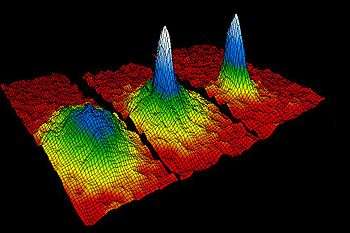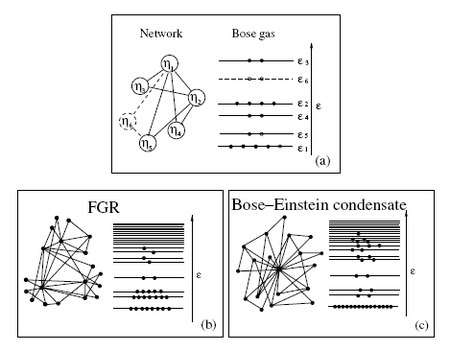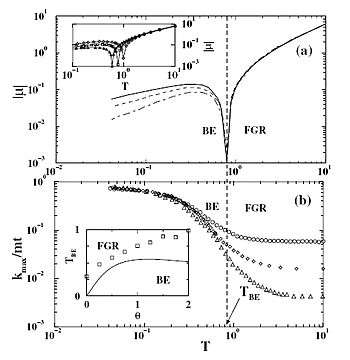Bose–Einstein condensation (network theory)

Bose–Einstein condensation in networks is a phase transition observed in complex networks that can be described with the same mathematical model as that explaining Bose–Einstein condensation in physics.
Background
In physics, a Bose–Einstein condensate is a state of matter that occurs in certain gases at very low temperatures. Any elementary particle, atom, or molecule, can be classified as one of two types: a boson or a fermion. For example, an electron is a fermion, while a photon or a helium atom is a boson. In quantum mechanics, the energy of a (bound) particle is limited to a set of discrete values, called energy levels. An important characteristic of a fermion is that it obeys the Pauli exclusion principle, which states that no two fermions may occupy the same state. Bosons, on the other hand, do not obey the exclusion principle, and any number can exist in the same state. As a result, at very low energies (or temperatures), a great majority of the bosons in a Bose gas can be crowded into the lowest energy state, creating a Bose–Einstein condensate.
A Bose–Einstein condensate is therefore a quantum phenomenon characteristic of boson particles. Nevertheless, a similar type of condensation transition can occur also in off-equilibrium classical systems and in particular, complex networks. In this context, a condensation phenomenon occurs when a distribution of a large number of elements in a large number of element classes becomes degenerate, i.e. instead of having an even distribution of elements in the classes, one class (or a few classes) become occupied by a finite fraction of all the elements of the system.
Condensation transitions occur in traffic jams, where long queues of cars are found,[1] in wealth distribution models[2] where a few people might have a finite fraction of all the wealth, or in Ising spin glass models.[3] However, the condensation transition in these models cannot in general be mapped to a Bose–Einstein condensation.
A network is characterized by a set of nodes or vertices and a set of links between these nodes. In mathematics, graph theory describes networks in general. The theory of random graphs deals in particular with stochastic networks (networks in which each link is present with a given probability p). A large class of networks that describe real complex systems like the Internet, the world wide web, airport networks or the biological networks of molecular interactions, are described by random networks. Network theory is a recent field of research which investigates methods of characterizing and modeling real complex networks. In particular it has been found that many complex networks have universal features like the small world property and a scale-free degree distribution. The scale-free degree distribution of networks can be caused by the "preferential attachment" mechanism.[4]
History
In the late 1990s, Ginestra Bianconi was a graduate student, working with Prof. Albert-László Barabási, a noted network theorist.[4] At his request, she began investigating the fitness model, a model in which the network evolves with the "preferential attachment" mechanism but in addition, each node has an intrinsic quality or fitness that describe its ability to acquire new links. For example, in the world wide web each web page has a different content, in social networks different people might have different social skills, in airport networks each airport is connected to cities with unevenly distributed economic activity, etc. It was found that under certain conditions, a single node could acquire most, if not all of the links in the network, resulting in the network analog of a Bose–Einstein condensate. In particular, a perfect analogy[5] could be drawn between the mathematics of the network and the mathematics of a Bose gas if each node in the network were thought of as an energy level, and each link as a particle. These results have implications for any real situation involving random graphs, including the world wide web, social networks, and financial markets.
The concept
The result of the efforts of Bose and Einstein is the concept of a Bose gas, governed by the Bose–Einstein statistics, which describes the statistical distribution of identical particles with integer spin, now known as bosons (such as the photon and helium-4). In Bose–Einstein statistics, any number of identical bosons can be in the same state. In particular, given an energy state ε, the number of non-interacting bosons in thermal equilibrium at temperature T = 1/β is given by the Bose occupation number
where the constant μ is determined by an equation describing the conservation of the number of particles
with g(ε) being the density of states of the system.
This last equation may lack a solution at low enough temperatures when g(ε) → 0 for ε → 0. In this case a critical temperature Tc is found such that for T < Tc the system is in a Bose-Einstein condensed phase and a finite fraction of the bosons are in the ground state.
The density of states g(ε) depends on the dimensionality of the space. In particular therefore g(ε) → 0 for ε → 0 only in dimensions d > 2. Therefore, a Bose-Einstein condensation of an ideal Bose gas can only occur for dimensions d > 2.
For a uniform three-dimensional Bose gas consisting of non-interacting particles with no apparent internal degrees of freedom, the critical temperature is given by:
where:
- n is the particle density;
- m is the mass per boson;
- h is Planck's constant;
- kB is the Boltzmann constant;
- ζ is the Riemann zeta function; and
- ζ(3/2) ≈ 2.6124.
Connection with network theory
The evolution of many complex systems, including the World Wide Web, business, and citation networks, is encoded in the dynamic web describing the interactions between the system’s constituents. Despite their irreversible and nonequilibrium nature these networks follow Bose statistics and can undergo Bose–Einstein condensation. Addressing the dynamical properties of these nonequilibrium systems within the framework of equilibrium quantum gases predicts that the “first-mover-advantage,” “fit-get-rich (FGR),” and “winner-takes-all” phenomena observed in competitive systems are thermodynamically distinct phases of the underlying evolving networks.[5]

Starting from the fitness model, the mapping of a Bose gas to a network can be done by assigning an energy εi to each node, determined by its fitness through the relation[6]
where β = 1 / T . In particular when β = 0 all the nodes have equal fitness, when instead β ≫ 1 nodes with different "energy" have very different fitness. We assume that the network evolves through a modified preferential attachment mechanism. At each time a new node i with energy εi drawn from a probability distribution p(ε) enters in the network and attach a new link to a node j chosen with probability:
In the mapping to a Bose gas, we assign to every new link linked by preferential attachment to node j a particle in the energy state εj.
The continuum theory predicts that the rate at which links accumulate on node i with "energy " εi is given by
where indicating the number of links attached to node i that was added to the network at the time step . is the partition function, defined as:
The solution of this differential equation is:
where the dynamic exponent satisfies , μ plays the role of the chemical potential, satisfying the equation
where p(ε) is the probability that a node has "energy" ε and "fitness" η = e−βε. In the limit, t → ∞, the occupation number, giving the number of links linked to nodes with "energy" ε, follows the familiar Bose statistics
The definition of the constant μ in the network models is surprisingly similar to the definition of the chemical potential in a Bose gas. In particular for probabilities p(ε) such that p(ε) → 0 for ε → 0 at high enough value of β we have a condensation phase transition in the network model. When this occurs, one node, the one with higher fitness acquires a finite fraction of all the links. The Bose–Einstein condensation in complex networks is therefore a topological phase transition after which the network has a star-like dominant structure.
Bose–Einstein phase transition in complex networks

The mapping of a Bose gas predicts the existence of two distinct phases as a function of the energy distribution. In the fit-get-rich phase, describing the case of uniform fitness, the fitter nodes acquire edges at a higher rate than older but less fit nodes. In the end the fittest node will have the most edges, but the richest node is not the absolute winner, since its share of the edges (i.e. the ratio of its edges to the total number of edges in the system) reduces to zero in the limit of large system sizes (Fig.2(b)). The unexpected outcome of this mapping is the possibility of Bose–Einstein condensation for T < TBE, when the fittest node acquires a finite fraction of the edges and maintains this share of edges over time (Fig.2(c)).
A representative fitness distribution ρ(η) that leads to a condensations
with λ = 1.
However, the existence of the Bose–Einstein condensation or the fit-get-rich phase does not depend on the temperature or β of the system but depends only on the functional form of the fitness distribution ρ(ν) of the system. In the end, β falls out of all topologically important quantities. In fact it can be shown that Bose–Einstein condensation exists in the fitness model even without mapping to a Bose gas.[7] A similar gelation can be seen in models with superlinear preferential attachment,[8] however, it is not clear whether this is an accident or a deeper connection lies between this and the fitness model.
Bose–Einstein condensation in evolutionary models and ecological systems
In evolutionary models each species reproduces proportionally to its fitness. In the infinite alleles model, each mutation generates a new species with a random fitness. This model was studied by the statistician J. F. C. Kingman and is known as the "house of cards" models.[9] Depending on the fitness distribution, the model shows a condensation phase transition. Kingman did not realize that this phase transition could be mapped to a Bose–Einstein condensation. Recently the mapping of this model to a Bose–Einstein condensation was made in the context of a stochastic model for non-neutral ecologies.[10] When the condensation phenomenon in an ecological system occurs, one species becomes dominant and strongly reduces the biodiversity of the system. This phase transition describes a basic stylized mechanism which is responsible for the large impact of invasive species in many ecological systems.
Memory understood as an equilibrium Bose gas
Herbert Fröhlich is the source of the idea that quantum coherent waves could be generated in the biological neural network. His studies claimed to show that with an oscillating charge in a thermal bath, large numbers of quanta may condense into a single state known as a Bose condensate.[11] Already in 1970 Pascual-Leone had shown that memory experiments can be modelled by the Bose–Einstein occupancy model.[12] From this and a large body of other empirical findings (based on studies of EEG and psychometrics) Weiss and Weiss draw the generalized conclusion that memory span can be understood as the quantum number of a harmonic oscillator, where memory is to be mapped into an equilibrium Bose gas.[13]
References
- ↑ M. R. Evans T. Hanney J. Phy. A: Math. Gen 38 (2005) R195-R239
- ↑ J. P. Bouchaud and M. Mezard Wealth Condensation in a simple model of economy, Physica A statistical Mechanics and its Applications 282 (2000) 536
- ↑ M. Mezard and A. Montanari, Information Physics and computation, Oxford Graduate Texts 2009
- 1 2 Barabási, Albert-László (2002). Linked. Cambridge, MA: Perseus Publishing. ISBN 0-7382-0667-9.
- 1 2 3 4 Bianconi, G.; Barabási, A.-L. (2001). "Bose–Einstein Condensation in Complex Networks." Phys. Rev. Lett. 86: 5632–35.
- ↑ Albert, R.; Barabási, A.-L. (2002). "Statistical mechanics of complex networks." Rev. Mod. Phys. 74: 47–97.
- ↑ Dorogovtsev, S. N.; Mendes, J. F. F. (2001). "Scaling properties of scale-free evolving networks: Continuous approach. Phys. Rev. E 63: 056125.
- ↑ Krapivsky, P. L.; Redner, S.; Leyvraz, F. (2000). "Connectivity of Growing Random Networks." Phys. Rev. Lett. 85: 4629–32.
- ↑ J. F C Kingman, A simple model for the balance between selection and mutation J. Appl. Prob. 15 (1978)1
- ↑ G. Bianconi L Ferretti and S. Franz, Non-neutral theory of biodiversity Europhys. Lett. 87 (2009) P07028
- ↑ Frohlich, H. (1968). Long range coherence and energy storage in biological systems. International Journal of Quantum Chemistry, 2, 641-649
- ↑ Pascual-Leone, J. (1970). A mathematical model for the transition rule in Piaget's developmental stages. Acta Psychologica, 32, 301-345
- ↑ Weiss V., Weiss H. (2003). The golden mean as clock cycle of brain waves. Chaos, Solitons and Fractals, 18, 643-652. Full text